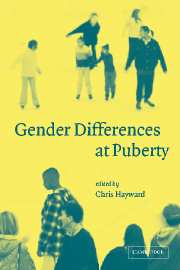Book contents
- Frontmatter
- Contents
- List of figures
- List of tables
- List of contributors
- Preface
- Acknowledgments
- 1 Methodological concerns in puberty-related research
- Part 1 Sex differences in hormones and their effect at puberty
- Part 2 Girls at puberty
- Part 3 Boys at puberty
- Part 4 Puberty and psychopathology
- Part 5 Pubertal timing: antecedents
- Part 6 Pubertal timing: consequences
- Part 7 Puberty and context
- Index
- References
1 - Methodological concerns in puberty-related research
Published online by Cambridge University Press: 22 September 2009
- Frontmatter
- Contents
- List of figures
- List of tables
- List of contributors
- Preface
- Acknowledgments
- 1 Methodological concerns in puberty-related research
- Part 1 Sex differences in hormones and their effect at puberty
- Part 2 Girls at puberty
- Part 3 Boys at puberty
- Part 4 Puberty and psychopathology
- Part 5 Pubertal timing: antecedents
- Part 6 Pubertal timing: consequences
- Part 7 Puberty and context
- Index
- References
Summary
Defining puberty
Puberty is not a single event, but rather a complex metamorphosis. It is a cascade of changes that result in adult appearance, adult physiology, and altered identity. Although sexual dimorphism, differences in form and structure between males and females, are initiated at conception, some of the most salient biological differences between males and females emerge during pubertal transition. However, identifying exactly when puberty begins has been difficult. It is easier to know that puberty has already started than to pinpoint its exact onset, since the initiation of puberty is not completely understood.
As described by Patricia Fechner in chapter 2, puberty consists of both adrenarche and gonadarche. Adrenarche occurs when the adrenal gland begins to increase production of androgen in both males and females, and is responsible for the development of pubic and axillary hair. This begins much earlier than what is typically thought of as the age of onset of puberty, beginning normatively as early as 6 years of age and typically having started by 8 years of age. Gonadarche is characterized by the development of the gonads, with increased release of estrogen in females and testosterone in males, which results in breast development in girls and testicular enlargement in boys.
As puberty is a process and not an event, its definition partly depends on the purpose for which the definition is being used. It is not necessary to measure hormones to define puberty if the purpose of the definition is to determine rate of growth.
- Type
- Chapter
- Information
- Gender Differences at Puberty , pp. 1 - 14Publisher: Cambridge University PressPrint publication year: 2003
References
- 13
- Cited by

